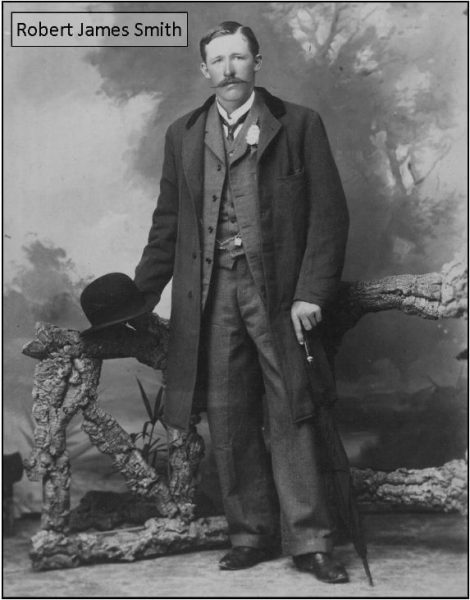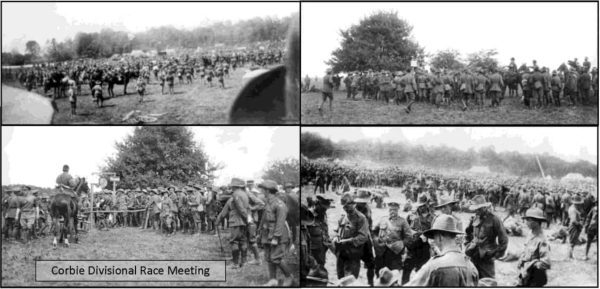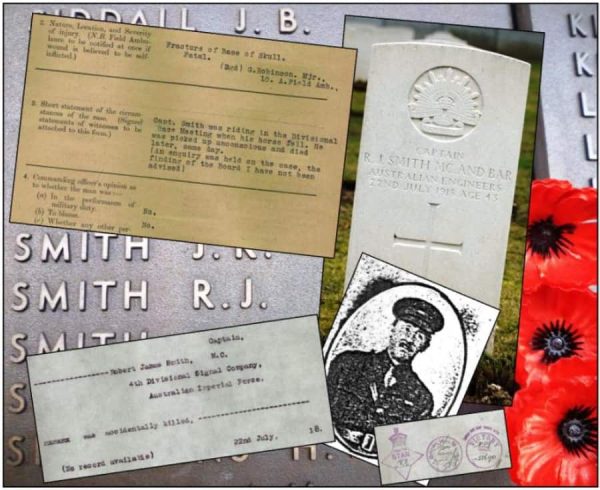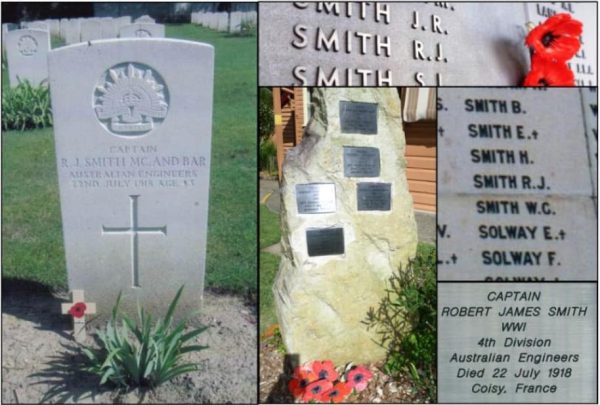Tomerong Anzacs: The Story of Captain Smith
This local story is part of our Researching Soldiers in Your Local Community NSW History project. Discover more like it or email your own research to digital@rahs.org.au for the opportunity to be published on the RAHS website.
Tomerong is a small town on the South Coast of New South Wales. During World War I, it was an even smaller village than it is today. Yet from that village, 28 men enlisted in the First Australian Imperial Force (AIF), more than meeting their regional quota. Six of them would never return home to Tomerong ever again.
Tomerong Anzacs: “I’ve Had My Fling” is the story of these 28 men, written and researched by local historian Ray Blair between 2015 and 2021. It is a remarkable study of a regional Australian community touched in every way by the First World War.
One of the most remarkable tales is that of Captain Robert James Smith.
 Robert Smith was born at Cedar Hill, Tomerong, on 19 August 1876, the youngest of ten children to William and Elizabeth Smith. His family were greatly involved in Tomerong community affairs including the local school and the Tomerong Literary & Debating Society. Two of his older brothers, George and Alexander, served in the Boer War.
Robert Smith was born at Cedar Hill, Tomerong, on 19 August 1876, the youngest of ten children to William and Elizabeth Smith. His family were greatly involved in Tomerong community affairs including the local school and the Tomerong Literary & Debating Society. Two of his older brothers, George and Alexander, served in the Boer War.
Robert was 39 when he enlisted as a Lieutenant in the 2nd Divisional Signal Company on 22 November 1915. He embarked from Melbourne on the HMAT Themistocles on 28 January 1916 as part of the 9th Reinforcements. As a Lieutenant he was to be paid 18 shillings a day, compared to a sergeant’s wage of 10 shillings, a corporal’s 9, and a sapper’s 5. [1]
After the Gallipoli campaign, the AIF was reinforced and reorganised into five divisions. Robert joined the new 4th Division on 9 March 1916 at Tel-el-Kebir in Egypt. By June he was in France, ready to be deployed as part of the Allied Somme offensive from 1 July.
The 4th Division Signal Company was the unit responsible for establishing and maintaining communications within the brigades of the division and with Divisional Headquarters. The primary task for the signallers involved laying telephone wires that required burying to prevent damage from artillery. This was hazardous as the ‘Linies’ had to carry the reels of wire above ground and bury the lines, attracting enemy fire. To avoid this, the task was often conducted at night but this created additional problems with ensuring locations and direction were correct. Once installed, the Linies were responsible for locating and repairing the damage as the lines were continually cut by artillery fire. Amplifiers (‘power buzzers’) were also used to boost the signal to achieve greater range. Radio would only appear later in the war.
In August 1916, the 4th Division relieved the 2nd Division in the Pozieres heights, a major German defensive position. During July the 1st and 2nd Australian Divisions had secured the village at great cost. Early on 7 August the Germans launched their final counter-attack that resulted in heavy hand-to-hand combat. It was on this day that Robert was recommended for his first Military Cross:
Gallantry in the Field and devotion to duty; Since this Division entered into the offensive … Lieut. SMITH has carried out work under most trying conditions and worthy of the highest praise and recommendation … When the shelling was so intense that the working party had to be withdrawn … Lieut. SMITH laid new lines and maintained them during this barrage of fire, thus restoring and ensuring communication between Brigades and Division. [2]
4th Division remained occupied just north of Pozieres, at Moquet Farm, in September and near Flers in October. Robert’s gallantry on the Somme front was not over. In February 1917, he was recommended for the Italian Silver Medal (the Italian equivalent of the Military Cross):
For bravery and devotion to duty … Lt Smith was in charge of lines which he maintained to the brigades under very severe shelling. He was at all times out encouraging his men by his example and work and it was mainly due to his efforts that the divisional communications were so good. He has always shown himself as being absolutely fearless in the execution of his work. [3]
Robert was promoted to captain in April 1917. 4th Division’s next major actions were the First Battle of Bullecourt (10 – 11 April), the Battle of Messines (7 – 14 June), and the Battle of Polygon Wood (26 September – 3 October). On 30 September 1917, Robert was recommended for a Mention in Despatches:
For gallantry and devotion to duty at Noreuil, 28 March to 14 April 1917, Messines, 6 to 14 June 1917, and Ploegsteert, 30 June to 20 July 1917. On each of these occasions Captain Smith has constructed six feet Buried Cable Routes to the front line, thus securing communications between front line and Division. [4]
The same month, he was recommended for a bar to his Military Cross:
For unceasing devotion to duty and gallantry. During the night of 24/25 September 1917, prior to this Division’s attack against the Zonnebeke Ridge, Captain Smith surveyed and constructed a six feet buried cable route to Anzac, and during and subsequent to consolidation on the new front line, 26, 27, 28 and 29 September, Captain Smith extended the route to within 200 yards of Tokio, in all a distance of 2,300 yards … Several times the work was held up by enemy shelling, but Captain Smith, by characteristic determination and dogged perseverance, completed the route in good time. [5]
In 1918, 4th Division fought against the German Spring Offensive at Amiens and Hamel. Following Hamel, the 4th Division retired out of the front line and was based at Coisy, 5km north of Amiens. On 22 July the division held a race meeting at Allonville Airfield on the Somme.
 A race was held for officers only just after noon, with a prize of 100 francs. Captain Robert James Smith entered, riding the horse ‘Etta’. He never finished. Etta and another horse fell and the riders were gravely injured. Captain Smith, aged 43, and Captain Ernest Kemmis, aged 25, both died of a fracture to the base of the skull as a result of the accident. Smith and Kemmis were buried alongside each other in St Pierre Cemetery, Amiens, on 24 July 1918.
A race was held for officers only just after noon, with a prize of 100 francs. Captain Robert James Smith entered, riding the horse ‘Etta’. He never finished. Etta and another horse fell and the riders were gravely injured. Captain Smith, aged 43, and Captain Ernest Kemmis, aged 25, both died of a fracture to the base of the skull as a result of the accident. Smith and Kemmis were buried alongside each other in St Pierre Cemetery, Amiens, on 24 July 1918.
The nature of Robert’s death was difficult for both his division and his family back home to accept. Delays in relaying the news meant that it took until September for the death to be reported in the Shoalhaven News:
In Wednesday’s issue of the Telegraph we published particulars of how Captain Robert J. Smith, one-time of Tomerong, made good at the Front as a member of the signalling and engineering corps, winning a commission and the military cross, a bar to the cross, and mention in despatches. It is our painful duty now to mention that this gallant officer met his death, not in action or on duty, but in the field of sport as the result of an accident. Details of the sad occurrence are given by Signaller Lindsay Brodie, in a letter to his parents from France, July 22nd, 1918 … ‘People outside have no idea what Capt. Smith was to us. He was a father to all our section. There was no man more respected than what he was … If he had been killed with a shell I don’t suppose we would have taken it so bad; but when a man boxes on for three years and then gets killed in sport like that, it is hard luck, and hard for his wife and family’. [6]
Robert’s belongings made their way to his widow, Isabella, in February and July 1919. In January 1920, she received a photograph of his grave at Amiens. His medals and memorial plaque were received in 1921 and 1923.
Robert James Smith is commemorated on panel 26 of the Australian War Memorial’s Roll of Honour, the Nowra Showground Memorial Gates Honour Roll, and the Tomerong Public School Memorial Garden.


‘The Story of Captain Smith’ is a summarised excerpt from the Tomerong Anzacs project, written and researched by Ray Blair. For more information, visit the Tomerong Past Facebook page.
References
[1] National Archives of Australia (NAA), Digital Service Record, Robert James Smith, https://recordsearch.naa.gov.au/SearchNRetrieve/Interface/ViewImage.aspx?B=1788344. Used as a source throughout the article.
[2] Australian War Memorial (AWM), Honours & Awards Army Form W3121, 11 Aug 1916, MC Recommendation, https://www.awm.gov.au/collection/R1584444.
[3] AWM, Army Form W3121, 06 Feb 1917, Italian Silver Medal Recommendation, https://www.awm.gov.au/collection/R1624866.
[4] AWM, Army Form W3121, 30 Sep 1917, Mentioned in Despatches Recommendation, https://www.awm.gov.au/collection/R1587221.
[5] AWM, Army Form W3121, 22 Oct 1917, DSO/Bar Recommendation, https://www.awm.gov.au/collection/R1629976.
[6] ‘The Passing of Capt. R. J. Smith’, Shoalhaven News and South Coast Districts Advertiser (1891-1937), 21 Sep 1918, p. 1, https://trove.nla.gov.au/newspaper/article/112543884.
